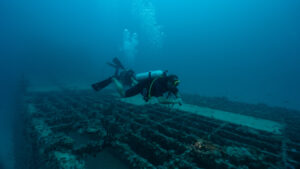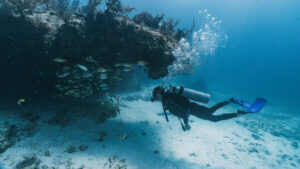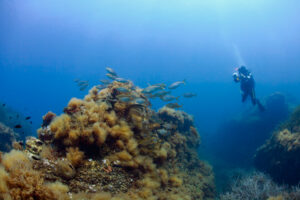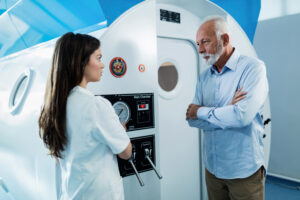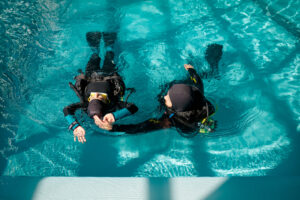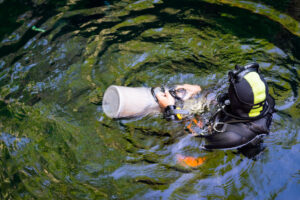What is the Auto-Closure Device (ACD)?
The Auto-Closure Device (ACD) represents a significant advancement in scuba diving technology, specifically within the realm of diving regulators. This device automatically seals the regulator’s first stage when it is detached from the cylinder, preventing water, contaminants, and particulates from entering the system. By maintaining a clean and dry first stage, the ACD significantly enhances the reliability and longevity of scuba equipment, thereby improving diver safety. This entry delves into the origins, technicalities, functionalities, and safety implications of the ACD, illustrating its crucial role in modern scuba diving.
Historical Development
The concept of an Auto-Closure Device (ACD) was born out of the need to improve the safety and reliability of diving regulators. Prior to the introduction of ACD technology, the first stage of a regulator, once disconnected from a tank, was susceptible to internal contamination from water and debris. Such contaminants could degrade the internal mechanisms, leading to potential failures under water—a risk unacceptable in diving, where equipment reliability can be a matter of life or death.
The development of the ACD began in earnest in the late 1990s, with several manufacturers experimenting with ways to integrate auto-sealing features into their existing designs. The first commercially successful ACD systems were introduced in the early 2000s. These systems employed a simple but effective mechanism that utilized the pressure difference between the inside of the regulator and the ambient environment to activate a closure as soon as the regulator was disconnected from the tank.
As adoption grew, the design was refined and standardized across different brands. Milestones in ACD technology included the introduction of materials better suited to saltwater environments and mechanisms that required minimal maintenance. Today, ACDs are widely regarded as an essential feature for mid to high-end regulators, favored by both recreational and professional divers for their robustness and reliability.
Technical Description
The Auto-Closure Device (ACD) works on a straightforward principle: it utilizes a spring-loaded mechanism to seal the regulator’s first stage inlet when the air pressure from a diving cylinder is no longer present. This mechanism consists of a movable seal which, in the connected state, is held open by the pressure of the tank. Once the pressure is released—typically when the diver disconnects the regulator from the tank—the spring forces the seal closed, effectively isolating the internal components of the first stage from the external environment.
Different manufacturers might employ variations in the specific design and materials used in ACD systems, but the underlying principle remains largely the same. For example, some designs might use a magnetic rather than mechanical action to secure the closure, aiming to reduce physical wear and tear and enhance the longevity of the seal.
Functionality and Benefits
The primary function of an ACD is to prevent water, dust, sand, and other environmental contaminants from entering the first stage of the diving regulator. This is crucial not only when the diver is entering and exiting the water but also during transportation and storage of the equipment. By maintaining a dry and clean first stage, the ACD significantly reduces the likelihood of corrosion and internal damage, thereby extending the overall service life of the regulator.
Moreover, the presence of an ACD contributes to better performance of the regulator. With fewer contaminants entering the system, the risk of clogging and malfunction decreases, ensuring a more reliable air supply under water. This is particularly beneficial in environments with high levels of particulate matter, such as silty or sandy waters.
The benefits of an ACD-equipped regulator extend beyond functionality to encompass significant maintenance advantages. Regulators with an ACD generally require less frequent and less intensive cleaning and servicing. For diving professionals and regular divers, this can translate into lower long-term costs and less downtime for equipment maintenance.
Furthermore, the ACD system enhances safety by providing an additional layer of protection against water entry into the regulator. In diving, where equipment failure can result in serious accidents or emergencies, the ability of the ACD to maintain a clean and operational regulator is a critical safety feature. The confidence in knowing that their breathing system is protected from the most common forms of contamination allows divers to focus more on their dive and less on potential equipment failures.
Safety Implications
The integration of ACD technology in scuba diving regulators significantly elevates diver safety. By preventing water and other environmental contaminants from entering the regulator’s first stage, the ACD minimizes the risk of malfunction, which is paramount during a dive. The scenarios where ACD proves most beneficial include diving in cold water, where regulator freezing is a concern, and diving in locations with high levels of particulates, like near sandy beaches or in silty underwater caves. In such environments, the risk of regulator free flow and blockages is higher, and ACD systems effectively mitigate these risks.
Additionally, the reliability offered by ACD systems helps in managing potential panic situations underwater. For instance, if a diver has to remove and replace their regulator, the ACD minimizes the entry of water during this process, ensuring that the air supply remains uncompromised. This aspect of ACD systems contributes to a safer and more controlled diving experience, especially for beginners who might be more prone to anxiety if faced with equipment issues underwater.
Installation and Maintenance
Installation of an ACD system is typically conducted by a professional technician. For existing regulators, retrofitting an ACD involves replacing the standard yoke or DIN fitting with one that includes the auto-closure mechanism. It’s essential for divers to consult with certified service centers to ensure compatibility of the ACD with their specific regulator model and brand.
Maintenance of ACD-equipped regulators does not deviate significantly from standard regulator maintenance, but there are a few additional considerations. Firstly, it is crucial to ensure that the ACD mechanism itself is free from debris and operates smoothly. During regular servicing, technicians should inspect the ACD for signs of wear and tear, ensure that the spring mechanism is functioning correctly, and replace any worn seals or components.
Regular cleaning after dives, particularly in saltwater, is vital to prevent salt deposits from interfering with the ACD function. Divers are advised to rinse their equipment in fresh water and operate the ACD mechanism several times to ensure that no salt residue is left within the mechanism.
Common Issues and Troubleshooting
Despite the reliability of ACD systems, they are not immune to issues. Common problems include the ACD failing to close properly due to sand, grit, or other small particles obstructing the seal. In such cases, it’s recommended to rinse the mechanism thoroughly and manually operate it several times to clear any blockages. If problems persist, the regulator should be taken to a service center for a more thorough examination and possible part replacement.
Another issue could be the weakening of the spring mechanism over time, which can cause the ACD to seal inadequately. This requires professional service to replace the spring and any other affected components to restore full functionality.
Key Takeaways
The Auto-Closure Device (ACD) has significantly impacted the scuba diving industry by enhancing the safety, functionality, and maintenance of diving regulators. As this technology continues to evolve, its integration into standard diving equipment will likely become more widespread, pushing the boundaries of what is possible in dive safety and reliability. The ongoing development of ACD technology not only reflects the continuous improvement ethos in the diving community but also reinforces the commitment to safety and innovation that defines the sport.




